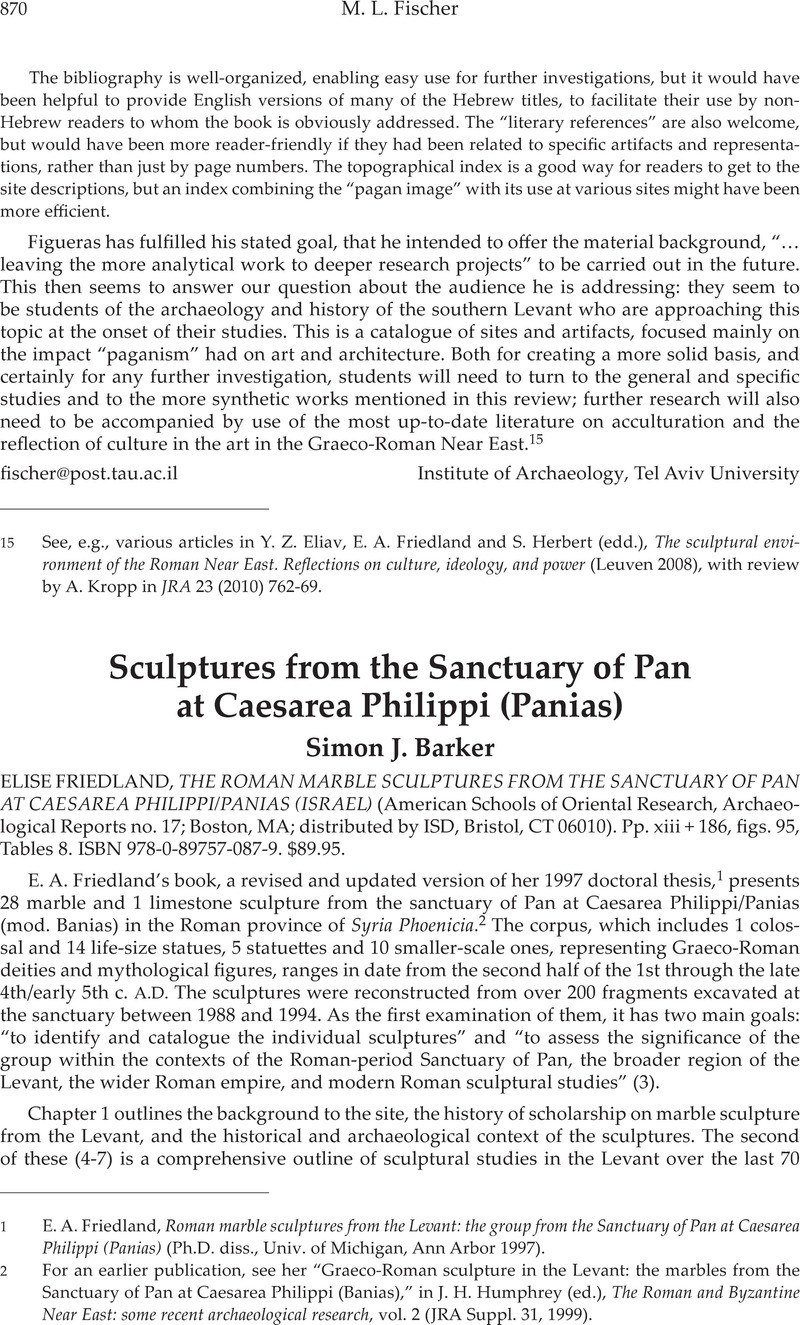No CrossRef data available.
Article contents
Sculptures from the Sanctuary of Pan at Caesarea Philippi (Panias) - ELISE FRIEDLAND, THE ROMAN MARBLE SCULPTURES FROM THE SANCTUARY OF PAN AT CAESAREA PHILIPPI/PANIAS (ISRAEL) (American Schools of Oriental Research, Archaeological Reports no. 17; Boston, MA; distributed by ISD, Bristol, CT 06010). Pp. xiii + 186, figs. 95, Tables 8. ISBN 978-0-89757-087-9. $89.95.
Published online by Cambridge University Press: 27 November 2014
Abstract

- Type
- Reviews
- Information
- Copyright
- Copyright © Journal of Roman Archaeology L.L.C. 2014
References
1 Friedland, E. A., Roman marble sculptures from the Levant: the group from the Sanctuary of Pan at Caesarea Philippi (Panias) (Ph.D. diss., Univ. of Michigan, Ann Arbor 1997)Google Scholar.
2 For an earlier publication, see her “Graeco-Roman sculpture in the Levant: the marbles from the Sanctuary of Pan at Caesarea Philippi (Banias),” in Humphrey, J. H. (ed.), The Roman and Byzantine Near East: some recent archaeological research, vol. 2 (JRA Suppl. 31, 1999)Google Scholar.
3 T. Weber, D. Kreikenbom, K.-U. Mahler and M. Koçak, The sculptures from Roman Syria II: the marble sculpture (forthcoming), should do much to bring together all the known Roman marble monuments from Lebanon, Syria, Jordan and Israel, and provide an even more thorough synthesis.
4 Brinkerhoff, D. M., A collection of sculpture in Classical and Early Christian Antioch (New York 1970)Google Scholar; Stucky, R. A., Die Skulpturen aus dem Eschmum-Heiligtum bei Sidon (Basel 1993)Google Scholar.
5 More detailed images would have helped the reader follow the descriptions.
6 On this topic see also Friedland, E. A., “Marble sculpture in the Roman Near East: remarks on import, production, and impact,” in Kristensen, T. M. and Poulsen, B. (edd.), Ateliers and artisans in Roman art and archaeology (JRA Suppl. 92, 2012) 55–74 Google Scholar.
7 Fischer, M. L. and Pearl, Z., “Excursus III. Provenance of marble imported to Roman Palestine: a geochemical, petrographic and artistic analysis,” in Fischer, M. L. (ed.), Marble studies: Roman Palestine and the marble trade (Konstanz 1998) 248–50 and 255–56Google Scholar; Pearl, Z., Archaeological marble in Israel: chemical and mineralogical analysis (M.Sc., Weizmann Institute of Science, Rehovot 1989)Google Scholar; Fischer, M. L., “Marble studies in Israel since Lucca 1988: a balance as the millennium turns,” in Lazzarini, L. (ed.), ASMOSIA 6 (Padova 2002) 320 Google ScholarPubMed.
8 On this point see chapters in Kristensen and Poulsen (supra n.6), and Smith, R. R. R., “Marble workshops at Aphrodisias,” in in D'Andria, F. and Romeo, I. (edd.), Roman sculpture in Asia Minor (JRA Suppl. 80, 2011) 62–76 Google Scholar.
9 See Skupinska-Løvset, I., Funerary portraiture of Roman Palestine (Gothenburg 1983)Google Scholar; ead., “The use of toothed tools in local workshops in relation to the question of sculptural techniques and choice in materials,” in Les ateliers de sculpture régionaux: techniques, styles et iconographie (Aix-en-Provence 2009) 417–24Google Scholar; I. B. Romano and M. L. Fischer, “Roman marble and limestone sculpture from Beth Shean, Israel,” ibid. 391-400.
10 It should be stressed that as this sculpture was recovered in the 19th c. its provenance is not secure.
11 Isaac, B., “Inscriptions from Banias,” in Paneion I: Excavations at the Sanctuary of Pan at Caesarea Philippi–Banyas, final report (Jerusalem, forthcoming)Google Scholar.
12 For an overview, see Friedland (supra n.6) and Skupinska-Løvset, I., Portraiture in Roman Syria (Gothenburg 1999)Google Scholar. Cf. also Vermeule, C. C. and Anderson, K., “Greek and Roman sculpture in the Holy Land,” Burlington Mag. 123 (1981) 7–19 Google Scholar.
13 In the case of more important or better-preserved pieces (i.e., cat. nos. 1-6), front, back and profile views are shown.
14 For Nysa-Scythopolis, see Romano and Fischer (supra n.9). For Caesarea Maritima, see Gersht, R., “The importation of sculpture to Caesarea,” in Rimon, O. (ed.), Caesarea: a mercantile city by the sea (Haifa 1995)Google Scholar and “Caesarean sculpture in context,” in Eliav, Y. Z., Friedland, E. A. and Herbert, S. (edd.), The sculptural environment of the Roman Near East (Leuven 2008) 509–38Google Scholar.




